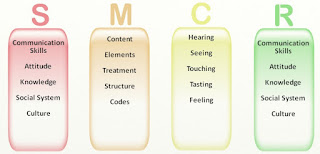Shannon and Weaver's Model of Communication
- Came in 1948 by Claude Elwood Shannon and published with an introduction by Warren Weaver for Bell Laboratories.
- Often referred to as the transmission model or standard view of communication
An information source, which produces a message.
A transmitter, which encodes the message into signals
A channel, to which signals are adapted for transmission
A receiver, which 'decodes' (reconstructs) the message from the signal.
A destination, where the message arrives.
Problems with the model:
- The technical problem: how accurately can the message be transmitted?
- The semantic problem: how precisely is the meaning conveyed?
- The effectiveness problem: how effectively does the received meaning affect behavior?
Flaws of the model:
- It assumes communicators are isolated individuals.
- No allowance for differing purposes.
- No allowance for differing interpretations.
- No allowance for unequal power relations.
Berlo’s Model of Communication
- Proposed by David Berlo in the sixties
- Expanded the linear model of communication
 |
| Linear Model Communication |
Components of Berlo's Model
S -Sender
- If the sender has good communication skills, the message will be communicated better than if the sender's communication skills are not good. Communication skills include the skills to speak, present, read, write, listening, etc.
- The person's attitude towards self, the receiver and the environment changes the meaning and effect of the message.
- Knowledge on the subject matter makes the communicator send the message effectively.
- Values, beliefs, laws, rules, religion and many other social factors affect the sender's way of communicating the message. Place and situation also fall under social systems.
- Cultural differences make messages different. A person from one culture might find something offensive which is very much accepted in another culture.
M-Message
- Content is the thing that is in the message. The whole message from beginning to end is the content.
- Elements are the non verbal things that tag along with the content like gestures, signs, language, etc.
- Treatment is the way in which the message is conveyed to the receiver. Treatment also effects the feedback of the receiver.
- The structure of the message or the way it has been structured or arranged, affects the effectiveness of the message.
- Code is the form in which the message is sent. It might be in the form of language, text, video, etc.
C-Channel
- The medium used to send the message. In mass communication and other forms of communication, technical machines might be used as a channel like telephone, internet, etc.
- In general communication, the five senses of a human being is the channel for the communication flow and it affects the effectiveness of the channel.
R- Receiver
- Communication skills
- Attitudes
- Knowledge
- Social Systems
- Culture
Criticisms of Berlo's SMCR Model:
- There is no concept of feedback, so the effect is not considered.
- There is no concept of noise or any kind of barriers in communication process.
- It is a linear model of communication.
- Both of the people must be similar according to all the factors mentioned above.
Schramm's Communication Model
- Proposed by Wilbur Schramm in 1954
- Indicated that a message’s (both desired and undesired) effect on the target must be examined
- Seen as processes of information transmission governed by three levels of semiotic rules:
- Syntactic (signs and symbols)
- Pragmatic (use of language)
- Semantic (meaning)
Components of Schramm's Model
- The person who originates a message is the source. The encoder and decoder are the same person/source. The second source is also encoder as well as decoder. The source acts as an encoder while sending the message and as decoder while receiving the message. The second source decodes the message, then originates another message, encodes it and sends it to the first source. The source is known to be encoder and decoder during the act of encoding and decoding.
- Message is the information sent during the interaction.
- The decoder forms a second message after receiving the first which is known as feedback.
- Field of experience is the experience and knowledge that the source possess which affects the message formation and interpretation. For example, the source's culture, social behavior, etc.
Strengths of Schramm's Model of Communication:
- Circular and dynamic communication gives opportunity to both parties to give their opinion.
- Semantic noise included as a concept helps in understanding problems that can occur during interpretation of message.
- Feedback makes it easier to know if the message is interpreted by the receiver as intended or not.
- Concept of context makes the environmental factor be included in interpretation of message and brings change in the message value.
Flaws of Schramm's Model of Communication
- This model can not deal with multiple levels of communication and complex communication processes.
- There can only be two sources communicating, many sources complicates the process and the model can not be implemented.
- Message sent and received might be interpreted differently than intended.




No comments:
Post a Comment